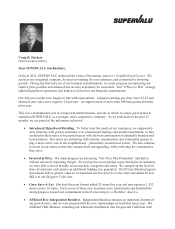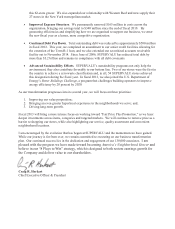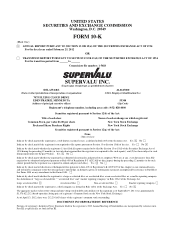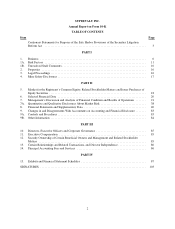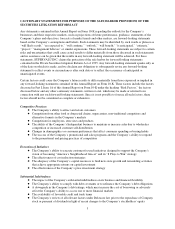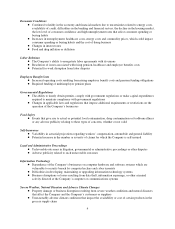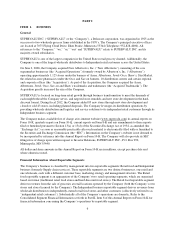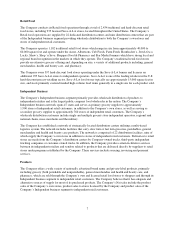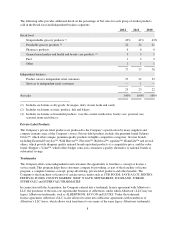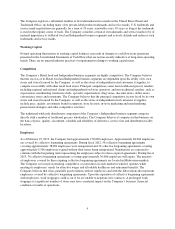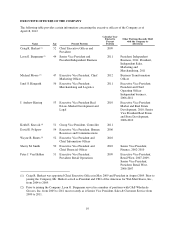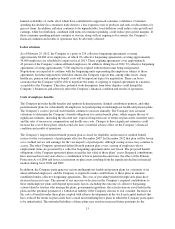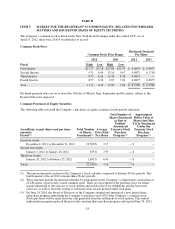Albertsons 2012 Annual Report Download - page 13
Download and view the complete annual report
Please find page 13 of the 2012 Albertsons annual report below. You can navigate through the pages in the report by either clicking on the pages listed below, or by using the keyword search tool below to find specific information within the annual report.The Company registers a substantial number of its trademarks/service marks in the United States Patent and
Trademark Office, including many of its private-label product trademarks and service marks. U.S. trademark and
service mark registrations are generally for a term of 10 years, renewable every 10 years as long as the trademark
is used in the regular course of trade. The Company considers certain of its trademarks and service marks to be of
material importance to its Retail food and Independent business segments and actively defends and enforces such
trademarks and service marks.
Working Capital
Normal operating fluctuations in working capital balances can result in changes to cash flow from operations
presented in the Consolidated Statements of Cash Flows that are not necessarily indicative of long-term operating
trends. There are no unusual industry practices or requirements relating to working capital items.
Competition
The Company’s Retail food and Independent business segments are highly competitive. The Company believes
that the success of its Retail food and Independent business segments are dependent upon the ability of its own
stores and stores licensed by the Company, as well as the stores of independent retail customers it supplies, to
compete successfully with other retail food stores. Principal competition comes from traditional grocery retailers,
including regional and national chains and independent food store operators, and non-traditional retailers, such as
supercenters, membership warehouse clubs, specialty supermarkets, drug stores, discount stores, dollar stores,
convenience stores and restaurants. The Company believes that the principal competitive factors faced by its own
stores and stores licensed by the Company, as well as the stores of independent retail customers it supplies,
include price, quality, assortment, brand recognition, store location, in-store marketing and merchandising,
promotional strategies and other competitive activities.
The traditional wholesale distribution component of the Company’s Independent business segment competes
directly with a number of traditional grocery wholesalers. The Company believes it competes in this business on
the basis of price, quality, assortment, schedule and reliability of deliveries, service fees and distribution facility
locations.
Employees
As of February 25, 2012, the Company had approximately 130,000 employees. Approximately 84,000 employees
are covered by collective bargaining agreements. During fiscal 2012, 56 collective bargaining agreements
covering approximately 38,000 employees were renegotiated and 32 collective bargaining agreements covering
approximately 5,500 employees expired without their terms being renegotiated. Negotiations are expected to
continue with the bargaining units representing the employees subject to those expired agreements. During fiscal
2013, 76 collective bargaining agreements covering approximately 36,000 employees will expire. The majority
of employees covered by these expiring collective bargaining agreements are located in Midwestern markets.
The Company is focused on ensuring competitive cost structures in each market in which it operates while
meeting its employees’ needs for attractive wages and affordable healthcare and retirement benefits. The
Company believes that it has generally good relations with its employees and with the labor unions that represent
employees covered by collective bargaining agreements. Upon the expiration of collective bargaining agreements
with employees, work stoppages could occur if we are unable to negotiate new contracts. A prolonged work
stoppage at a significant number of stores may have a material impact on the Company’s business, financial
condition or results of operations.
9


